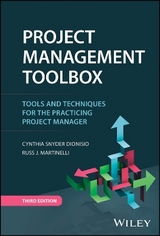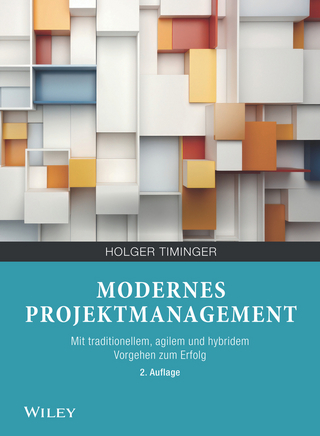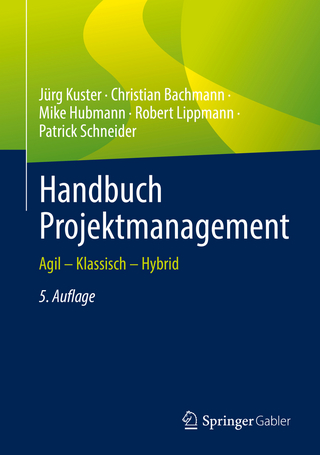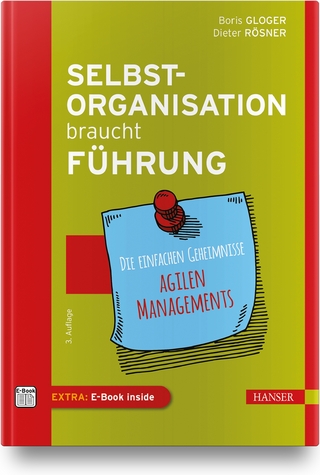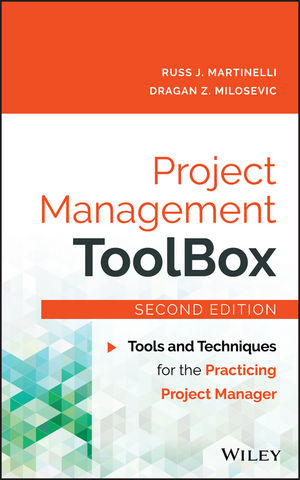
Project Management ToolBox
John Wiley & Sons Inc (Verlag)
978-1-118-97312-7 (ISBN)
Boost your performance with improved project management tactics Project Management ToolBox: Tools and Techniques for the Practicing Project Manager, Second Edition offers a succinct explanation of when, where, and how to use project management resources to enhance your work. With updated content that reflects key advances in the project management field, including planning, implementation, control, cost, and scheduling, this revised text offers added material that covers relevant topics, such as agility, change management, governance, reporting, and risk management. This comprehensive resource provides a contemporary set of tools, explaining each tool's purpose and intention, development, customization and variations, and benefits and disadvantages. Additionally, examples, tips, and milestone checks guide you through the application of these tools, helping you practically apply the information you learn.
Effective project management can support a company in increasing market share, improving the quality of products, and enhancing customer service. With so many aspects of project management changing as the business world continues to evolve, it is critical that you stay up to date on the latest topics in this field.
Explore emerging topics within the world of project management, keeping up to date on the latest, most relevant subject areas
Leverage templates, exercises, and PowerPoint presentations to enhance your project management skills
Discuss tips, reporting, implementation, documentation, and other essentials of the project management field
Consider how project management fits into various industries, including technology, construction, healthcare, and product development
Project Management ToolBox: Tools and Techniques for the Practicing Project Manager, Second Edition is an essential resource for experienced project managers and project management students alike.
RUSS J. MARTINELLI has served as a program manager at Intel, Loral, and Lockheed Martin, and is a founder of the Program Management Academy. He also provides training and consulting services to companies in both the for-profit and non-profit sectors. DRAGAN Z. MILOSEVIC, PHD, PMP, has been an Associate Professor of Engineering and Technology Management at Portland State University (Oregon), a consultant and trainer, and has conducted seminars in many parts of the world. He is the author of multiple books and dozens of papers on the subject of project management.
Preface xv
Acknowledgments xvii
Part I: The PM Toolbox 1
1 Introduction to the PM Toolbox 3
Enabling Business and Project Strategy 5
Project Management Methodologies and Processes 7
Constructing and Adapting a PM Toolbox 9
Secure Strategic Alignment 10
Customize the PM Toolbox 12
Continuously Improve the PM Toolbox 20
References 21
Part II: Project Initiation Tools 23
2 Project Selection 25
The Benefits Map 25
Enabling Benefits Management 26
Developing a Benefits Map 28
Using a Benefits Map 29
Variations 30
Benefits 31
Economic Methods 31
Payback Time 31
Net Present Value 31
Internal Rate of Return 33
Using Economic Methods 33
Benefits of Economic Methods 34
Scoring Models 34
Developing a Scoring Model 34
Using a Scoring Model 39
Benefits 40
Voting Models 40
Developing a Voting Model 41
Using the Voting Model 42
Benefits 45
Pairwise Ranking 46
Developing a Pairwise Ranking Tool 47
Using the Pairwise Ranking Matrix 48
Benefits 49
The Alignment Matrix 49
Developing the Alignment Matrix 50
Variations 51
Benefits 52
References 52
3 Project Initiation 55
Checklist Questions for Project Initiation 55
Developing Checklist Questions for Project Initiation 56
Using the Checklist Questions 57
The Goals Grid 57
Developing a Goals Grid 58
Using the Goals Grid 59
Benefits 60
Responsibility Matrix 60
Developing a Responsibility Matrix 61
Using the Responsibility Matrix 63
Benefits 64
Complexity Assessment 64
Developing the Complexity Assessment 65
Using the Complexity Assessment 67
Benefits 67
The Project Business Case 68
Developing the Project Business Case 68
Using the Project Business Case 70
Benefits 71
The Project Charter 71
Developing a Project Charter 71
Using a Project Charter 76
Variations 77
Benefits 77
References 78
Part III: Project Planning Tools 81
4 Project Requirements 83
The Elicitation Plan 84
Developing an Elicitation Plan 86
Using the Elicitation Plan 89
Benefits 90
Requirements Specification 91
Specifying a Requirement Using Planguage 91
Using the Requirements Specificiation 93
Benefits 96
The Product Requirements Document 96
Developing a Product Requirements Document 97
Using the PRD 101
Benefits 102
Requirements Ambiguity Checklist 102
Using the Requirements Ambiguity Checklist 104
Benefits 106
Requirements Baseline 106
Establishing a Requirements Baseline 107
Establish a Requirements Change Board 107
Benefits 108
References 109
5 Scope Planning 111
Project SWOT Analysis 111
Performing a Project SWOT Analysis 112
Using a Project SWOT Analysis 116
Benefits 117
The Scope Statement 118
Developing a Scope Statement 118
Using a Scope Statement 124
Variations 124
Benefits 125
The Work Breakdown Structure 126
Constructing a Project WBS: A Top-Down Approach 128
Establish the WBS Level of Detail 130
Constructing a Project WBS: A Bottom-Up Approach 134
Using the WBS 135
Benefits 136
The Product Breakdown Structure 137
Constructing a Product Breakdown Structure 137
Using the PBS 141
Benefits 141
References 142
6 Schedule Development 145
The Gantt Chart 146
Developing a Gantt Chart 146
Using the Gantt Chart 149
Benefits 149
The Milestone Chart 150
Developing a Milestone Chart 151
Using the Milestone Chart 153
Benefits 154
The Critical Path Method Diagram 154
Constructing a CPM Diagram 155
Using the CPM Diagram 160
Benefits 161
Variations 161
The Time-Scaled Arrow Diagram 162
Developing a TAD 162
Using a TAD 167
Benefits 168
The Critical Chain Schedule 168
Developing a Critical Chain Schedule 169
Using the Critical Chain Schedule 172
Benefits 173
The Hierarchical Schedule 173
Constructing a Hierarchical Schedule 174
Using a Hierarchical Schedule 176
Benefits 177
Line of Balance 177
Developing a Line-of-Balance Schedule 178
Using the LOB 180
Benefits 181
Choosing Your Scheduling Tools 181
References 183
7 Cost Planning 185
The Cost-Planning Map 185
Developing a Cost-Planning Map 186
Using the Cost-Planning Map 191
Benefits 191
Analogous Estimate 191
Developing an Analogous Estimate 192
Using an Analogous Estimate 193
Benefits 193
Parametric Estimate 194
Developing Parametric Estimates 194
Using Parametric Estimates 198
Benefits 198
Bottom-up Estimate 199
Developing Bottom-Up Estimates 200
Using Bottom-Up Estimates 202
Benefits 202
The Cost Baseline 203
Developing a Cost Baseline 203
Using the Cost Baseline 207
Benefits 208
Choosing a Cost-Planning Tool 211
References 211
Part IV: Project Implementation Tools 213
8 Scope Management 215
Project Scope Control System 217
Establishing a Project Scope Control System 217
Using the Project Scope Control System 220
Benefits 223
Project Change Request 223
Developing a Project Change Request 224
Using the Project Change Request 228
Benefits 229
The Project Change Log 229
Developing a Project Change Log 230
Using the Project Change Log 232
Benefits 233
The Scope Control Decision Checklist 233
Developing a Scope Control Decision Checklist 233
Using the Scope Control Decision Checklist 234
Benefits 235
References 235
9 Schedule Management 237
The Burn Down Chart 239
Developing the Burn Down Chart 239
Using the Burn Down Chart 240
Benefits 242
The Slip Chart 243
Developing the Slip Chart 244
Using the Slip Chart 246
Benefits 246
The Buffer Chart 247
Developing the Buffer Chart 248
Using the Buffer Chart 249
Benefits 250
The Jogging Line 251
Constructing a Jogging Line 252
Using the Jogging Line 255
Variations 256
Benefits 256
The Milestone Prediction Chart 257
Constructing the Milestone Prediction Chart 258
Using the Milestone Prediction Chart 260
Benefits 260
B-C-F Analysis 261
Performing the B-C-F Analysis 262
Using the B-C-F Analysis 264
Benefits 265
Schedule Crashing 265
Performing Schedule Crashing 265
Using Schedule Crashing 269
Benefits 269
Choosing Your Schedule Management Tools 269
References 270
10 Cost Management 273
Cost Management Plan 275
Developing the Cost Management Plan 275
Using the Cost Management Plan 276
The Budget Consumption Chart 276
Developing the Budget Consumption Chart 277
Using the Budget Consumption Chart 278
Variations 279
Benefits 279
Earned Value Analysis 280
Performing Earned Value Analysis 281
Using Earned Value Analysis 292
Variations 293
Benefits 293
Milestone Analysis 294
Performing a Milestone Analysis 295
Using the Milestone Analysis 297
Benefits 297
Choosing Your Cost Management Tools 297
References 298
11 Agile Project Execution 301
Contributed by Peerasit Patanakul, James Henry, Jeffrey A. Leach
Scrum Basics 302
Product Backlog and Sprint Backlog 304
Information on the Backlogs 304
Populating Backlogs 304
Benefits 306
Release Planning 307
The Release-Planning Event 308
Initial Draft Release Plan 309
Final Release Plans 309
HIP Sprint 310
Release Planning versus Sprint Planning 310
Benefits 311
The Daily Scrum Meeting 311
Organizing a Daily Scrum Meeting 312
Benefits 312
Sprint Task Board 313
Using the Sprint Task Board 313
Benefits 314
The Sprint Burn Down Chart 315
Developing a Sprint Burn Down Chart 315
Using a Sprint Burn Down Chart 316
Benefits 317
The Sprint Retrospective Meeting 317
Organizing a Sprint Retrospective Meeting 318
Using a Sprint Retrospective Meeting 318
Benefits 320
Concluding Remarks 320
References 321
Part V: Project Reporting and Closure Tools 323
12 Performance Reporting 325
Project Reporting Checklist 325
Developing the Project Reporting Checklist 326
Using the Project Reporting Checklist 326
Benefits 326
The Project Strike Zone 328
Developing the Project Strike Zone 328
Using the Project Strike Zone 330
Benefits 332
The Project Dashboard 332
Designing a Project Dashboard 334
Using the Project Dashboard 335
Benefits 336
The Summary Status Report 337
Developing a Summary Status Report 337
Using the Summary Status Report 342
Benefits 343
The Project Indicator 343
Developing the Project Indicator 345
Using the Project Indicator 346
Variations 346
Benefits 348
Choosing Your Reporting Tools 349
References 349
13 Project Closure 351
Contributed by Tim Rahschulte, PhD
Understanding Project Closure 351
Project Closing Activities 353
Project Closure Plan and Checklist 356
Developing the Plan and Checklist 358
Using the Closure Plan and Checklist 362
Benefits 362
The Project Closure Report 363
Developing the Project Closure Report 363
Using the Project Closure Report 365
Benefits 365
Postmortem Review 366
Conducting the Postmortem Review 366
Using the Postmortem Review 369
Variations 371
Benefits 372
Concluding Remarks 373
References 373
Part VI: Risk and Stakeholder Management Tools 375
14 Managing Project Risk 377
Risk Management Plan 378
Developing a Risk Management Plan 378
Using the Risk Management Plan 385
Benefits 386
The Risk Identification Checklist 387
Developing a Risk Identification Checklist 387
Using a Risk Identification Checklist 389
Benefits 389
The Risk Register 390
Creating a Risk Register 390
Using the Risk Register 393
Benefits 394
The Risk Assessment Matrix 394
Developing a Risk Assessment Matrix 395
Using the Risk Assessment Matrix 397
Variations 398
Benefits 398
Monte Carlo Analysis 399
Performing a Monte Carlo Analysis 400
Using the Monte Carlo Analysis 408
Benefits 409
The Decision Tree 409
Analyzing the Decision Tree 410
Using Decision Trees 413
Benefits 414
The Risk Dashboard 414
Developing the Risk Dashboard 414
Using the Risk Dashboard 418
Benefits 418
Choosing Your Risk Management Tools 420
References 420
15 Influencing Project Stakeholders 423
The Stakeholder Management Plan 423
Developing a Stakeholder Management Plan 424
Using the Stakeholder Management Plan 427
Benefits 427
The Stakeholder Map 428
Developing a Stakeholder Map 428
Using the Stakeholder Map 431
Benefits 431
The Stakeholder Analysis Table 431
Developing a Stakeholder Analysis Table 433
Using the Stakeholder Analysis Table 434
Benefits 435
The Stakeholder Evaluation Matrix 436
Developing a Stakeholder Evaluation Matrix 438
Using the Stakeholder Evaluation Matrix 439
Variations 441
Benefits 443
The Stakeholder Strategy Matrix 444
Developing a Stakeholder Strategy Matrix 444
Using the Stakeholder Strategy Matrix 446
Benefits 447
Choosing Your Stakeholder Management Tools 447
References 449
Final Thoughts on the PM Toolbox 449
Index 451
| Verlagsort | New York |
|---|---|
| Sprache | englisch |
| Maße | 163 x 241 mm |
| Gewicht | 816 g |
| Themenwelt | Technik ► Maschinenbau |
| Wirtschaft ► Betriebswirtschaft / Management ► Projektmanagement | |
| ISBN-10 | 1-118-97312-7 / 1118973127 |
| ISBN-13 | 978-1-118-97312-7 / 9781118973127 |
| Zustand | Neuware |
| Informationen gemäß Produktsicherheitsverordnung (GPSR) | |
| Haben Sie eine Frage zum Produkt? |
aus dem Bereich
